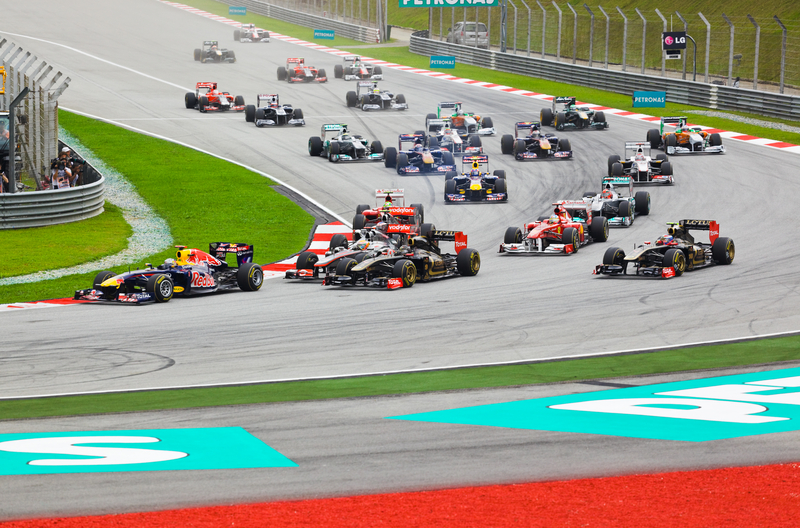Last updated on October 30th, 2023 at 12:35 pm
The fastest an F1 car has ever gone is 256.75 miles per hour. Jenson Button set that record in a late model Red Bull while driving in the Bonneville Salt Flats. However, it’s unlikely that you’ll see an F1 car reach those speeds during a race.
Here’s what you can expect to see on race day.
How Fast Do Formula 1 Cars Go On-Track?
While Jenson Button set the all-time fastest speed in a Formula 1 car, they usually go much slower on the track. Cars are their fastest during qualifying sessions when there’s minimal fuel in the gas tank, and they’re using all the resources available to put down the quickest lap in the hunt for pole position during the grand Prix. Valtteri Bottas set the unofficial speed record for any F1 car on track in 2016 when he drove his Williams at 231.46 miles per hour at the Azerbaijan Grand Prix in Baku.
The design of F1 tracks limits how fast the cars can go for safety reasons. As drivers navigate a racetrack, they often have to reduce speeds in braking zones or turns. Operating a vehicle at high speeds for an extended period puts excessive pressure on the car and can heat the tires past their optimal temperature range. As a result, F1 drivers manage their speeds throughout a race.
Race conditions can also affect how fast drivers operate their vehicles during a Grand Prix. While fans might assume that rain is the most important thing to impact a car, they may be surprised to find that a crosswind can severely affect how a vehicle handles. Similarly, debris on the track like sand can compromise handling, forcing drivers to go slower during a race.
What are the Fastest Tracks in F1?
Formula One generally organizes its different race tracks into two camps, high-downforce tracks and power tracks. High-downforce tracks rely on aerodynamics to keep the cars stable as they go through obstacles like chicanes, essess, and long turns. Meanwhile, power tracks are high-speed tracks that push the vehicles to their limit on every lap.
The fastest track on the F1 calendar is the Italian Grand Prix at Monza. The Dutch Grand Prix at Zandvoort is a close second. These tracks feature a sweeping banked turn that allows drivers to maintain high cornering speeds. They also have multiple straightaways and plenty of DRS zones that encourage intense straight-line speed.
What Helps F1 Cars Go So Fast?
Compared to other vehicles, the design of F1 cars is to go fast. They often perform better at high speeds than they do at slow ones. The fastest F1 cars reach top speeds of well over 220 miles and a 0-60 speed of about two seconds. That’s similar to many road cars, like the Tesla Model S Plaid edition.
When they’re at their top speed, Formula 1 cars generate a tremendous amount of downforce to keep them stable. F1 teams manipulate downforce by adjusting structures like the car’s rear wing to press the car into the ground as it drives. As the car moves faster, more force is applied to the body, keeping it on the ground and stable.
The design of Formula 1 cars has good power to weight ratio. A vehicle moves more efficiently the lighter it is and the more power it produces. Most F1 cars only weigh about 1,759 pounds. However, the powerful F1 engines, which feature a turbocharged V6 and energy recovery system, produce over 1,000 horsepower, helping these vehicles reach blistering speeds.
Are F1 Cars Faster than Other Race Cars?
F1 cars are the fastest cars off track compared to other racing series but lag behind other race cars on track. They trail only slightly behind IndyCar vehicles, which can easily reach speeds of 230 or more when racing on oval tracks. Again, since many F1 circuits feature unique obstacles, they tend to go much slower during races.
However, F1 cars are much faster than NASCAR stock cars, which only reach about 200 miles per hour during a race. This speed difference is partly because NASCAR cars are much bigger and heavier than F1 cars. That weight means that NASCAR vehicles are much less efficient, even with larger engines.
Conclusion: How Fast do F1 Cars Go?
Next time you watch an F1 race, pay attention as your favorite driver goes through the speed traps. You’ll likely be surprised that they have such impressive vehicle control at such high speeds. Not only is their speed impressive, but so are the drivers’ reactions as they maneuver against the course and other drivers.
However, even if the car is setting down impressive lap times, the on-track speed won’t come close to the blistering pace drivers can set off-track. For instance, if drivers had a straight shot down the road, they could go much faster than on regular track courses. While the on-track speeds aren’t as fast as those off-track, you can still appreciate the driver’s skill as they push their cars to the limit in competition for the World Championship.
Similar Posts:
What Does Interval Mean in F1?
How Many Laps in a NASCAR Race?
What is the Difference Between NASCAR
How Many Cars are in a NASCAR Race?
What is the Difference Between NASCAR and F1?
How Do You Become a NASCAR Driver?
Greg Kristan, owner of The Stadium Reviews, LLC and TM Blast, LLC, brings his extensive experience visiting over half of the MLB ballparks, along with numerous MLS, NHL, NBA, and NFL venues, to provide in-depth coverage on the bag policy, food options, and parking. He has also been interviewed about his experiences on several sports podcasts.






